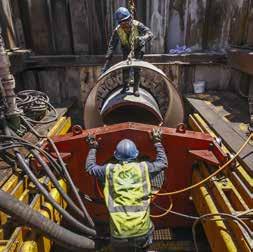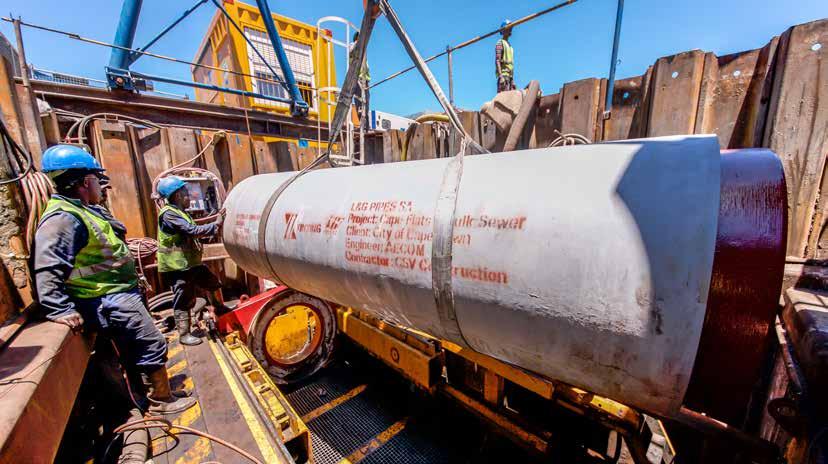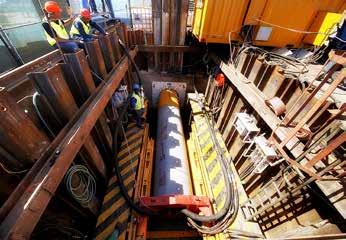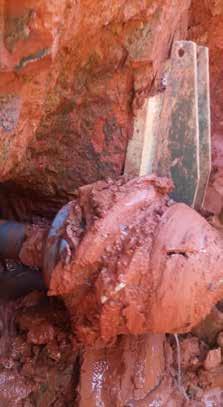
8 minute read
Trenchless Technology
TRENCHLESS PIPELINE REHABILITATION: TECHNICAL AND PRACTICAL CONSIDERATIONS

Advertisement
South Africa’s urban population is growing at about 150% of the national rate and has doubled over the past 26 years. This has put an enormous strain on the existing urban water services and increased the need for installing new ones. By Alaster Goyns*
South Africa’s pipelines are and operate. If the environmental been established and little or no the arteries and veins of our resources are damaged, the people excavation is needed for their communities, delivering and the economy on which rehabilitation. This means clean and removing dirty they depend will suffer the footprint during water. If they are not healthy, then the consequences. rehabilitation is the population’s health will suffer There needs to be a only a fraction of the consequences. change in the way that needed for
There are two components to this: these services are open trench first, the densification of the established provided, which replacement, urban areas where these pipelines have takes a holistic where there is deteriorated with age and in many cases view of the space needed have inadequate capacity; and second, long-term health for the trench, the mushrooming of informal and of society and the excavated semiformal settlements, which are only environment in material and partly serviced or not serviced at all. which we live. the movement of construction The challenge Benefits of trenchless equipment. In both situations, the problem of rehabilitation Before making any installing new or rehabilitating existing Many of the existing water services that decisions about how to buried pipelines is compounded are malfunctioning can be rehabilitated rehabilitate an existing pipeline, it is by the fact that there is generally at a direct cost that is significantly less essential that practical constraints on insufficient space for effectively doing than their replacement cost, without the particular site are ascertained and this using the traditional way of digging even considering the social, commercial understood, along with how these are trenches, which causes social and and environmental inconveniences, going to be technically addressed using business disruption and environmental disruption and associated costs. Once the technology available. damage, plus the associated costs rehabilitated, these services can provide and inconvenience. a virtually trouble-free useful life of Technical and
What is usually not appreciated is between 50 and 100 years, or longer, practical considerations the interdependence of these factors. provided the correct design parameters Once the social needs and Our communities are not just people are used. environmental constraints for a and their businesses; they include the The basic reason for this is that the particular pipeline are established environment within which we live route for these services has already (whether a new or existing pipeline in

need of rehabilitation), the technical means of meeting these requirements can be addressed. For water pipelines, the primary requirement will always be the hydraulic capacity to meet the specified demand at the end of a given period. There are, however, the secondary support functions of strength, water-tightness and durability, which are needed to ensure that the primary requirement is efficiently and effectively met. These are all interrelated, especially when the long-term serviceability is considered in terms of the pipe/soil system, whether this is a full flowing pressure or a partly full flowing gravity pipeline and the pipe material that was or is going to be used. Hydraulic requirements There are significant differences between the way that full flowing pressure systems and partly full flowing gravity systems operate. For a full flowing pipeline, such as a water supply pipeline, the velocity through the whole pipeline will be the same, provided the pipe diameter and discharge are constant. The velocity and discharge will be directly related to and determined by the slope of the total energy line, excluding transition losses. This means that if the discharge drops by a certain percentage, the velocity will drop by the same percentage. A reduction in velocity is no problem if there are no solids being carried in suspension; however,



if there are solids in suspension, a drop in velocity can cause them to settle out and gather in any low sections along the pipeline. These deposits can consolidate and, in so doing, reduce the flow area. This means that when the discharge through the system increases at a later stage, the velocity through this section with a smaller cross section will increase even more.
For a pipeline flowing partly full, such as a sewer or stormwater drain, the velocity and hence the discharge along the pipeline will depend upon the invert gradient, even though the pipe diameter remains constant. The velocity and discharge have a relationship dependent upon the geometric properties of the flow area, the wetted perimeter of the pipeline and the flow depth, which is in turn dictated by the invert gradient. At low flow depths, the discharge is only a small percentage of the full flow value, so the velocity will not reduce by the same amount. This means that if the discharge drops by a certain percentage, the velocity will drop by the same percentage. By way of example, at a flow depth that is 20% of the pipe diameter, the discharge will only be 10% of the full flow discharge, but the velocity will be 62% of the full flow value. Hence the advantage of using a conduit with a circular, rather than flat, invert.
When dealing with the rehabilitation of sewers, nothing can be done to rectify any problems with existing gradient; however, close-fit liners – such as cured-in-place pipe, spirally wound liners and others – where the reduction of internal diameter is minimal, usually result in a slight increase in flow velocity and capacity.
This is because they are continuous from manhole to manhole, there are no joints and they have a smooth surface. This reduces the siltation problem, as the velocities are slightly higher and the washing of fines through leaking joints is eliminated. For smaller-diameter reticulation and collector sewers (up to about 450 mm in diameter) not placed at depth, any seriously damaged pipes or pipes that have settled seriously relative to adjacent pipes can be replaced as point repairs by excavating from the surface. The whole line can then be relined and replacing the whole pipeline is avoided.
In urban areas where densification has taken place, the existing pipelines may need upgrading to improve capacity. This can be done by using on-line replacement techniques, such as pipe bursting, splitting or reaming. With these techniques depending on ground conditions, it is possible to upsize an existing pipeline by twice its diameter, which will increase its capacity by over six times. Although this could significantly upgrade the water services in those parts of South Africa where densification is taking place, the benefits of this feature are seldom implemented.
Structural requirements When considering the rehabilitation of pipelines, the structural requirements will depend upon whether the host pipe still has the strength to carry the loads imposed on it or not, and is on the brink of collapse. In the former case, the host pipe is classified as being partially deteriorated and the liner is placed to make the pipeline watertight and protect it from corrosion. In the latter case, the host pipe is classified as being fully deteriorated (or more appropriately as being at the point of collapse) and the liner is designed as if it has to carry all of the imposed load.
If a pressure pipeline is to be rehabilitated, the liner must be designed for two different loading cases, namely when the pipeline is empty, where the critical condition is the external groundwater pressure that develops between the liner and the host pipe, and the other is when the pipeline is flowing full under maximum capacity. For the former condition, the liner needs to have the required stiffness to prevent it buckling under this external pressure. Under the latter condition, the liner needs to have the required tensile strength to resist the internal pressure.
For a sewer lining, the loading that must be considered is the external groundwater pressure, which develops between the liner and the host pipe, assuming the pipeline is empty.
Pipelines, and sewers in particular, are frequently installed in low-lying areas below the flood plains of rivers. This means that the external water pressure could at times be above ground level and the liner must be designed to handle this.

Concluding comment Trenchless techniques provide costeffective ways of rehabilitating pipelines and avoid the inconvenience and disruption of the conventional open trench replacement of pipelines in densely populated urban and environmentally sensitive areas.
The Southern African Society for Trenchless Technology (SASTT) is a small voluntary association that is committed to contributing towards solving the country’s problems with the provision and upgrading of water and other buried services.
The challenge to all parties involved in providing water services is to change their mindset to help them realise that the technical and practical means of providing quality water pipelines are available – and that the long-term social, environmental and economic benefits far outweigh the short-term savings obtained by reducing the pre-construction costs of assessing the social needs and environmental constraints required as the input into the planning, design and construction of these essential services.
In reality, the provision of these water services is primary healthcare and their quality is essential.
*Alaster Goyns is the owner of PIPES cc and a board member of SASTT.










